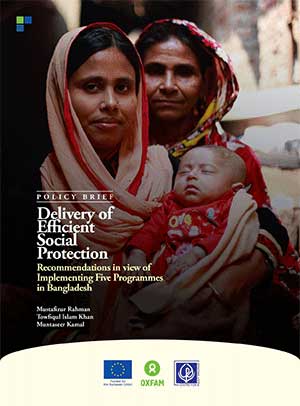 Delivery of Efficient Social Protection
Delivery of Efficient Social Protection
Recommendations in view of Implementing Five Programmes in Bangladesh
Social protection and social safety net programmes (SSNPs) are critically important enablers to attain the Sustainable Development Goals (SDGs) at the country level. This is particularly pertinent when the implementation of the SDGs in line with the spirit of ‘leave no one behind’ is considered. Delivering SSNPs at the grassroots level calls for the involvement of several actors, including the central authorities, local governments (LGs), and local administrations (LAs). At the aggregate level, it is the state’s responsibility to deliver the SDGs, but local authorities play a crucial role in the actual delivery on the ground. This role of local authorities is also explicitly mentioned in the SDG framework. However, in most cases, the gap between expectation and reality in delivering public service provision to the furthest behind population in Bangladesh has remained quite significant. Several studies have pointed out the shortcomings in this connection. These include, inter alia, inadequate allocation, limited coverage, mistargeting, leakages, coordination failure among the implementing agencies, high administrative costs and inefficiencies, and absence of any impact evaluation framework.
In this context, the present policy brief focuses on the effectiveness of the delivery of five selected SSNPs in Bangladesh. These include maternity allowance, primary and secondary school stipend programmes (PESP and SESP, respectively), employment generation programme for the poorest (EGPP), and old-age allowance. The idea is to identify the gaps between policies and praxis and offer some policy recommendations. As is known, these selected programmes provide basic social protection to citizens against attendant risks at various stages of the life-cycle viz. early childhood, school age, working-age, and old-age. The programmes are also more wide-ranging in nature as these are not specifically targeted towards any explicit social group. Furthermore, these are large in terms of both budgetary allocation and coverage compared to other programmes. Delivery of these programmes was examined in four north-west districts of Bangladesh: Nilphamari, Rangpur, Kurigram, and Gaibandha. The primary reason for selecting these particular districts is that as per the upper poverty line, the poverty headcount ratio for these four districts exceeded 30 per cent in 2016 in contrast to the corresponding national average figure of 24.3 per cent.
Authors: Mustafizur Rahman, Towfiqul Islam Khan and Muntaseer Kamal
Publication period: February 2021



